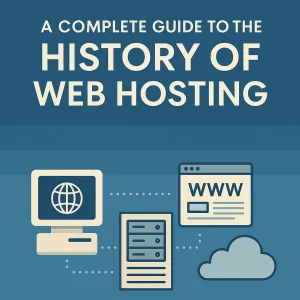What we see today—the websites, the cloud servers, online shopping, video calls, and endless streaming—is definitely the product of decades of experiments, bold innovations, trials, and errors. There was a time when all these things were pulled together from clunky computer connections in research labs into what has become a global system supporting billions of websites for businesses, entertainment, and everyday communication.
Every single domain name and website can now be created just within a few minutes with the assistance of a quite affordable website hosting service provider in Canada. This wasn't the case during the 1960s and 70s, when the first major breakthrough was connecting a pair of computers across the country.
Understanding the technology is what makes the journey into web hosting so fascinating. It shows us how far we have come, and it also shows us how much each advance in technology has geared future advances that are now taken for granted.
This blog will be looking at A Timeline History of Web Hosting 1965 - 2001, retracing the journey via milestone events from the first computer networks and launching out of the commercial hosting industry. Buckle up and join us for this trip down memory lane to explore how web hosting evolved into what we know today as the backbone of the internet.
1965–1991: The Internet’s Infancy
Web hosting history did not emerge out of cool websites and colorful pages, a simple answer, yet there weren’t any. Rather, it starts with the very idea of the internet itself: a bunch of experiments aimed at gradually connecting computers into networks to share information across long distances.
Those baby steps were radical, and though they might seem quite crude from today’s perspective, they laid the foundation for everything we take for granted in that hosting world.
1965: The First Connection
That was where it all began. MIT people were able to successfully link two computers using packet-switching technology; rather than just sending information as one continuous stream, the data were broken up into so-called "packets" that travelled over a network and were reassembled at the destination. It might sound a little technical, but packet-switching would become the very backbone of how the internet works. For the first time in history, computers could "talk" to each other over a network-a seed planted for what will grow in the future into worldwide connectivity.
1969: The Birth of ARPANET
Just a few years down the line, the American dept. of defense-launched ARPANET, the ancestor of the internet; ARPANET had linked four main research institutions: UCLA, Stanford, UC Santa Barbara, and the University of Utah. Tiny as it was, the concept was revolutionary. For the first time, researchers could share information across vast distances instantly, without the need for physical media like floppy disks or paper reports. ARPANET, with limited application, was working, but it wasn't Public Yet. It had shown that networked computing had been achievable and Inc., and now, it would show how useful it will become.
1974: The First Internet Service Provider (ISP)
Around this time, in the mid-'70s, ideas were beginning to coalesce about the commercialization of access to networks. Enter Telenet in 1974- the first commercial version of ARPANET, which went on to be known as the first Internet service provider. The real meaning was that Telenet became world's first commercial Internet service provider. For the first time, access to a network was opened up not only to government bodies or universities but also to businesses and individuals. Admittedly, web hosting then wasn't even a term that could be thought about (because there weren't any websites) but Telenet at least opened commercial Internet use putting down one of the very early stepping stones toward the hosting industry.
1983: The Birth of DNS and Domains
Up until the early 1980s, connecting to any server meant typing in a long, intimidating string of numbers called the IP address. Certainly, this was not at all user-friendly. That was transformed with the introduction of the Domain Name System in 1983. Just like that, websites could be identified by simple, easy-to-remember names with endings like .com, .org, or .edu. Again, this was like replacing complicated GPS coordinates with street addresses everyone in the neighborhood remembers. Merely two years after the introduction of DNS in 1985, the first domain address to be officially registered was symbolics.com. This was a major milestone for the notion of owning and naming a website to become viable and approachable, which, in turn, would lay the very foundation for all the services that hosting companies would subsequently provide.
1991: The World Wide Web Goes Public
And then came that big bang moment for the internet as we know it today. In 1991, British scientist Tim Berners-Lee placed the code of the World Wide Web in the public domain. Conceived at CERN as a means for scientists to share research, the web was based on a hypertext system of clickable links from one page to another.
What is even more interesting is that Berners-Lee hosted the very first website on his own NeXT computer at CERN. The website was a simple, text-based webpage outlining what the World Wide Web was and how anyone else could go about creating their own web server. This was simple web hosting, one computer serving one website to anybody who was up for it.
With the birth of the World Wide Web, the internet quickly transitioned from being a specialist's playground to something to which, eventually, anyone, anywhere, could gain access. And sure, it was basic in the early days, laying the bedrock for a booming hosting industry around the corner.
1992–2001: The Dot-Com Revolution and the Hosting Boom
The '90s were like the teenage years of the Internet: rapid growth, big dreams, and, of course, a few dramatic failures. With the public opening of the World Wide Web, the demand for websites surged, and thus the rise of web hosting as an industry.
A digital gold rush was sweeping through this decade. Let's take a look at some key milestones.
1993: Passing the Browser Wars and Into the Hands of the Common Person
The World Wide Web was made usable by the common man who registered for the Mosaic browser in 1993. Unlike earlier text-based browsers, Mosaic featured a graphical user interface that allowed individuals to click links, see images with text, and navigate without typing in complex commands.
This advancement alone made the Internet that much more accessible to the average user. With the popularity of browsing, websites were rapidly set up from universities to institutions to simple private hobby sites. But then came the big question of all questions regarding websites. Where to host all these files?
Enterprising companies saw an opportunity: They began offering web hosting services. Consequently, the title "web host" was no longer niche, but big business.
1995: The Birth of Shared Hosting
In the mid-90s, everybody wanted a website—small businesses, bloggers, hobbyists, you name it. But the problem was that it wasn't only expensive to run a personal server; it was also very technical.
The simple option was shared hosting.
In 1995, GeoCities, Tripod, and Angelfire were pioneering this model, where multiple websites share the resources of a single server. It reduced cost so dramatically that hosting became something millions of people could afford.
- GeoCities became extremely popular at the time for its free hosting. Put some banner ads on your page, and we will host your site for free. In a way, it democratized the web for anyone with a bit of computer knowledge to set up a personal site.
- Shared hosting was the mainstay of the dot-com boom, but it later laid a concrete foundation for hosting providers to scale to a global clientele.
In some ways, shared hosting was the first actual step toward the modern-day affordable website hosting service provider in Canada and worldwide.
Commercialization and Competition in Late 1990s
As the Internet started expanding, expectations expand ed alongside it. Free hosting was perfect for hobbyists, but real businesses demanded greater resources, control, and security. Hence arose commercial hosting services whereby clients paid for professional-grade infrastructure.
- Dedicated Hosting and the Increase in Professional Services: While shared hosting was perfect for hobbyists, businesses and high-traffic websites required the power, control, and security that only dedicated hosting could supply. In simple terms, this meant that single servers could be rented to a single client. This arrangement continues to provide e-commerce sites and corporate portals with unparalleled performance and security, and such was the popularity of dedicated hosting rather early. As competition intensified, so did the differentials among hosting companies: email hosting, bigger storage, and very advanced management tools. This was the "Wild West" out there in hosting, battling it out to see who would innovate the greatest or snatch up the most customers and carve the future of the industry. It was an earnest beginning of the cheap website hosting service provider.
- Colocation : The Prerequisite for the Data Center. With growth, the company routed its servers through some of their own installations, but most of those servers are housed in very professional facilities for very high-speed networks, power redundancy, and advanced cooling. This practice, called colocation, became the most popular alternative to dedicated hosting, allowing complete operation of the hardware while providing very rich infrastructure through a specialized data center. This marked the beginning of the modern data center industry, which is one of the real physical backbones of the internet.
2000–2001: The Dot-Com Bust and Maturation
By 2000, the internet had somehow transformed from a curiosity into an economic giant. Startups in the thousands were trying to launch a website hoping to find success in the dot-com boom. Hosting companies were renting out server space like crazy to an endless influx of new businesses.
And then all of a sudden, there was a crash.
The bubble burst between 2000 and 2001, and hundreds of startups never made it out of the gate, having spent the investor money with very little earnings and rarely viable business models. Many websites disappeared almost overnight.
Yet, still, the hosting sector survived. In some respects, the crash has pushed the hosting companies toward greater efficiency and sustainability. From this pressure came a new form of innovation:
- Virtual Private Servers (VPS): With virtualization technology, hosting providers can now split one physical server into several virtual ones. Each VPS behaves like a real independent server with allocated resources and its own operating system.
- VPS hosting quickly became the perfect compromise: more control and performance than shared hosting, yet much cheaper than dedicated hosting.
And it was here that VPS meant an inflexion point: by 2001, hosting had matured into a structured industry operating a wide range of services—from free shared hosting for the hobbyists, dedicated servers for enterprises, and VPS to fill the flexible space in between.
The Big Picture, 2001
Web hosting, by now, has metamorphosed from something of a parking concept to being the very foundation of the digital economy. From the mother of all experimentations in basement servers in academic institutions had emerged an industry generating billions all over the globe, supporting businesses, individuals, and organizations.
This now set the platform for a new spurt of innovations: cloud hosting, managed services, and the digital-first world we inhabit today.
From Hosting to Cloud: 2001-2025
The dot-com crash did not kill web hosting in 2001; it refined it. Cost innovation and smarter ways of delivering reliable services became the key terms for most companies that survived and thrived. Articulately matured by this buzzword hype, the industry turned into that structured ecosystem we know so well-with layers of hosting solutions for every single hobbyist to global enterprises. Let's just break it down from 2001 till now.
Virtualization from 2001 to 2007: Rise of the VPS
After the bust, hosting providers needed flexible, cost-effective ways to serve customers. Enter Virtual Private Servers (VPS), made possible by advances in virtualization technology.
VPS hosting allowed one physical server to be divided into multiple virtual ones, each acting as its own independent server. This was revolutionary-it gave small and mid-sized businesses more control and performance without paying for an entire dedicated server.
Canadian providers, during that time, were adopting VPSs to offer local businesses scalable solutions while being compliant with Canadian laws on data.
Managed hosting also started to thrive whereby companies took over the technical side (patches, updates, monitoring) to focus less on maintaining servers and more on growing the business.
The Cloud Revolution-2008 to 2014
The biggest shift since the web has probably been cloud computing, which began from late 2000 into the early 2010s.
Amazon Web Services (AWS) (2006) and later Google Cloud and Microsoft Azure recast the hosting field. The renting did not mean renting one single server anymore but elastic computing power that could scale on demand. The limits came off dramatically with cloud hosting. Whether you had 100 or 1,000,000 visitors, your hosting could grow instantly.
For Canadians, the local data center became essential. With PIPEDA and then various secondary regulations (like healthcare and finance), Canadian firms wanted to keep careful data domestic. Hosting companies like 4GoodHosting saw this as an opportunity to provide Canadian cloud hosting with the promise of onshore servers, true flexibility with compliance.
2015-2019: Security, Speed, and SEO All Shouldered Center Stage
Websites were dynamic, no longer simple static pages on the internet-e-commerce to streaming to SaaS platforms-now security, speed, as well as visibility, occupied the stage.
SSL certificates became common practice, with no exceptions. Google even went so far as to promote sites secured with HTTPS in its ranking system.
CDNs-think Cloudflare and Akamai-were repackaged into the marketplace, allowing websites to access super-fast worldwide cache data storage as close to the user as possible.
Mobile-first might become a necessity in addition to these categories. The first day when smartphones topped desktop and surface use, optimization had to start with speed and responsiveness in delivering the sites through the servers and platform.
Canadian providers rode increasingly high on their local benefits-the point that customers in Canada would enjoy faster load times, impressive data residency compliance, and better SEO for national companies.
This was when 4GoodHosting extended itself from merely providing land on a server to helping businesses in Calgary, Edmonton, and Toronto with better websites, safe infrastructure, and stronger local visibility.
2020: Progress to 2025-The Age of Edge Hosting and AI
Digital transformation was speeded up by the years of the pandemic. Those businesses unwilling to consider online sales hastened to put up websites, and hosting changed once again.
- Edge Hosting, Edge Computing: Instead of depending solely on a centralized data center, the idea of the provider started to lean toward a more distributed form of edge servers closer to the end user for the anticipated effect of less latency. For example, such an installation would have been vital for video calling, streaming, and gaming.
- AI-based hosting mangers: Forms of tools have been unveiled which predict upsurges in traffic, resource autoscaling, and even identify possible future cyber-attacks before they might actually happen.
- Green hosting: With increasing awareness towards environment friendliness, hosting became a huge trend associating itself with clean energy. Canadian dealers boast that they are one of those sustainable trends.
- One-stop platforms: Hosting was quite limited to servers at one time; it was inclusive of SEO tools, website builders, domain registrations, and marketing add-ons.
And now, in 2025, web hosting is at the center of a hyper-connected, always-on world. From AI websites that update themselves to immersive AR/VR experiences hosted on high-performance servers, the industry continues to reinvent itself.
Hosting in Canada: A Growing Presence
Whereas the early web hosting history primarily showcased itself in America and Europe, Canada, silently yet steadily, was building up its own digital ecosystem. Certainly, the Canadian hosting industry had neither the relative fame nor the initial visibility such that it would raise much of a clamor. Still, it was carefully laying an important bedrock upon which the online future of the country would be built.
Early Canadian ISPs and Hosting Providers
By the mid-to-late 1990s, as the internet became part of our everyday lives, the giants of Canadian telecom Bell, Rogers, and Shaw saw another opportunity and began rolling out basic hosting packages bundled with internet access. At first, services were simple--take email accounts, static storage, and small amounts of bandwidth. But for businesses in Canada that wanted to dip their freezing toes in the online water, it was a game-changer.
With the heavyweights came a maze of independent providers. Small one-man operations popped up all over the cities of Toronto, Vancouver, and Montreal.
Why Canadian Hosting Used to Be Important
So, with all the conveniences associated with Canadian hosting, it's the very essence of answering real needs:
- Data residency laws: With the enactment of PIPEDA (Personal Information Protection and Electronic Documents Act) in the year 2000, it put a premium on protecting Canadians' personal data. Hence, hosting data in Canada became a compliance advantage, most especially for those whose business involved sensitive data like healthcare or finance.
- Speed & SEO: A speedier access made local hosting faster for sites catering to Canadian audiences. Faster sites meant happier users-and better local search engine rankings, an early but crucial edge for entering into the growing world of SEO.
- Support for small businesses: Probably most importantly, hosting in Canada provided low-budget solutions to small businesses, entrepreneurs, and community groups. No longer would establishing a web presence mean exorbitant foreign provider fees; they would simply rely on a more affordable, within-their-reach website hosting service provider in Canada that understands their needs and their market.
These windows into compliance, performance, and affordability gave birth to today's vibrant Canadian hosting landscape. What began as simple ISP add-ons has today formed a robust competitive industry with offerings ranging from shared hosting to cloud platforms.
Industry Impact & Cultural Shifts
An incredible transformation took place in people's lives between technology, business practices, and social lives by web hosting.
- Small businesses found a global audience with simple hosted sites because now any mom-and-pop shop in Calgary or Halifax could sell their goods worldwide. Geography ceased to act as a barrier.
- Personal expression exploded: Free and inexpensive hosting services let everybody create a blog, build a fan page, or set up a forum, and for many it was their first taste of publishing for a global audience.
- Startup culture in a big way: The dot-com start-up culture emerged in the 90's and early 2000's. Affordable hosting put anyone and everyone with an idea in touching distance of creating a site. Many of these ventures crashed with the bubble, but the culture of experimentation never died.
- Digital democratization: Hosting leveled the playing field. The internet was no longer a playground just for big corporations or universities—it became accessible to students, hobbyists, small businesses, and entire communities.
From a fringe service, hosting evolved by the early years of the 21st century into a strong structural feature of modern life. The trifecta of innovation, affordability, and openness to the world and Canada prepared the ground for the next: cloud hosting, social media, and the ever-on digital world we know today.
Some Sidebars and Fun Facts(sprinkle all over)
- Did You Know? : AT&T was the first provider of a banner ad on the HotWired.com site in October of 1994. It was just a beautiful, simple graphic with the pioneering question: "Have you ever clicked your mouse right here?" It led to a virtual tour of art museums and boasted an incredible 44% click-through rate. Given that the average nowadays does below 1% click rate, it was a huge success. It has been demonstrated that online advertising could be a lucrative business model, opening up new avenues to a revenue-driven internet.
- GeoCities Eviction : GeoCities was one behemoth in personal web hosting in the late 1990s. Before it was acquired by Yahoo in 1999 for an astounding $3.57 billion, the service hosted an amazing number of nearly 38 million user-created pages. It was the third most visited website in the world after AOL and Yahoo itself. The US version was taken down in 2009, which basically evicted millions of users and erased a huge part of early internet history. Fortunately, dedicated archival efforts like the Internet Archive and Project GeoCities managed to save some of that digital heritage so that it could be glimpsed into the creative, quirky, and sometimes chaotic worlds of the early web.
- A Domain Older than the Web : On March 15, 1985, a computer company called Symbolics, Inc. registered the domain Symbolics.com. This is the very first .com domain name ever registered and predates the public release of the World Wide Web by six years! Although the original company went out of business long ago, the domain continues to live as a digital artifact. Visit Symbolics.com, and you will, in effect, find it as a kind of online museum of the history of the Internet, serving to remind one that the ways of building the infrastructure of the Internet were already growing before most of us knew what it was.
- Canada and Its Digital Hubs : As the world zoomed ahead with the internet, physical infrastructure was becoming urgent. Although the early web was largely US-centric, Canada quickly established its own infrastructure. In the late 1990s, Canada's first major commercial data centers began popping up in technology hubs such as Toronto and Vancouver. They would become pivotal in assuring fast and reliable hosting services to Canadian businesses and users, where local data would both be stored and accessible locally. These earliest data centers are the ancestors of what today are termed modern interconnected networks of servers powering Canadian web hosting.
Conclusion: From Wires to Websites
Are you ready for the final act? Once traveling from a couple of linked computers at MIT, we now have the entire industry with dedicated, shared, and virtual private servers. Clearly, the history of web hosting is not just a history of technology; it is the story of innovation, affordability, and the very impetus to link the world. From the first website, which ran on a single computer, to the coexistence of thousands of websites on a single shared server, each radical move was designed to open the web to many more people. The dot-com boom was undeniably a circus, but it taught the industry to mature and pay more attention to sustainable reliability services that it could offer or seek. That's exactly what has become of the legacy today - that resilience and adaptability define the hosting market. An instance, this company-https://4goodhosting.com.
A company like 4goodhosting enters the picture as a web hosting company in Canada, building on the shoulders of giants who laid the groundwork from 1965 to 2001. Its services, from VPS to shared ones, bear testament to such history. The history of affordable website hosting service provision in Canada is but a continuation of the spooling and making of websites accessible and reliable for both corporate and personal use, and making sure the digital world can get stronger with every new site going live.
4GoodHosting's legacy and technology unite in fast, safe, and scalable hosting today. A reliable online presence is ensured by 4GoodHosting whether local study is for small businesses or trustworthy infrastructure for large enterprises. A big chunk continues to be telegraphed on the principles of affordability, performance, and customer-first innovation in web hosting while creating future legacies for the digital landscape of Canada.















